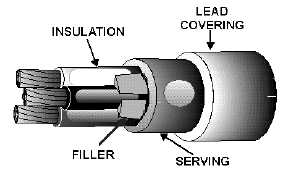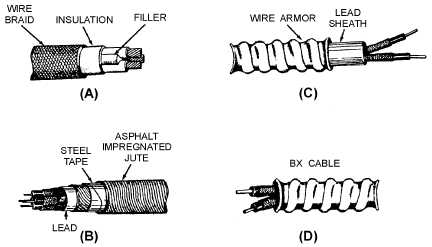1-23
Figure 1-16 is an example of a lead-sheathed (jacketed) cable used in power work. This cable is a
standard three-conductor type. Each conductor is insulated and then wrapped in a layer of rubberized
tape. The conductors are twisted together, and rope or fillers are added to form a round core. Over this is
wrapped a second layer of tape called a serving. Finally, a lead sheath is molded around the cable.
Figure 1-16.—Lead-sheathed cable.
Lead-sheathed cable is one of three types currently being used: alloy lead, pure lead, and reinforced
lead. An alloy-lead sheath is much like a pure lead sheath but is manufactured with 2-percent tin. This
alloy is more resistant to gouging and abrasion during and after installation. Reinforced lead sheath is
used mainly for oil-filled cables where high internal pressures can be expected. Reinforced lead sheath
consists of a double lead sheath. A thin tape of hard-drawn copper, bronze, or other elastic metal
(preferably nonmagnetic) is wrapped around the inner sheath. This tape gives considerable additional
strength and elasticity to the sheath, but must be protected from corrosion. For this reason, a second lead
sheath is applied over the tape.
Metallic Armor
Metallic armor provides a tough protective covering for wires and cables. The type, thickness, and
kind of metal used to make the armor depend on three factors: (1) the use of the conductors, (2) the
environment where the conductors are to be used, and (3) the amount of rough treatment that is expected.
Figure 1-17 shows three examples of metallic armor cable: wire braid, steel tape, and wire armor.
Figure 1-17.—Metallic armor cable.
WIRE-BRAID ARMOR.—Wire-braid armor (view A of figure 1-17 ), also known as basket-weave
armor, is used when light and flexible protection is needed. Wire braid is constructed much like fibrous



